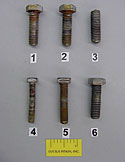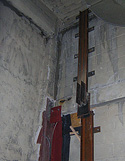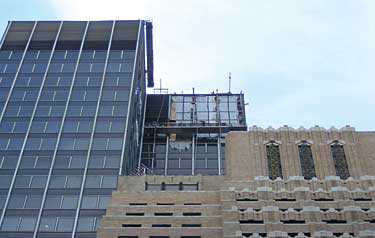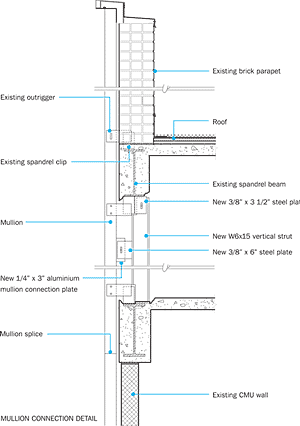Sleuthing the Mundane and the Catastrophic
After completion of the stabilization process, the team was free to focus its attention on the rest of the building envelope. It began examining representative sections of the facade and the connections between the curtain wall and the building structure wherever these were not hidden by interior finishes, finding many locations where bolts tying the mullions to the building's structure at spandrel beams were missing. Wear on brackets and plates indicated that fasteners had been originally installed but had backed out over time. The building was a relatively early curtain-wall tower, and the facade system did not use fasteners with locking devices, explains Mancini. "It was not until the '70s or '80s that these curtain-wall systems were refined."
At the owner's urging, the inspection quickly expanded to examination of all of the nearly 2,000 connections between the facade and the tower's structure. In the case of curtain walls, "there is no textbook [formula] for determining how much investigation is enough," says Eric Hammarberg, Thornton Tomasetti vice president.
Over the course of the next six or seven months, during weekends and after normal working hours, the Thornton Tomasetti team and the contractor examined every mullion bracket and spandrel beam clip. These connections, hidden on both the exterior and interior, were accessed through the convection units within offices using a device called a borescope that links an objective lens to an eyepiece with a flexible tube.
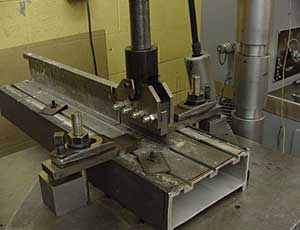 |
LPI tested a portion
of recovered mullion (above) from the Midtown Manhattan office building's failed section of curtain wall to determine the load-carrying capacity of the weld holding the clip to the mullion. However, no deficiencies were found. |
The investigators found that the locations with missing bolts were concentrated primarily at the corners and at the upper floors, the areas of the building subject to higher wind loads. When locations with missing fasteners were found, the contractor replaced them on the spot with new stainless-steel bolts and nylon threaded nuts.
The specified repair for the failed area of curtain wall (above) included construction of the previously omitted connections between the mullions and the building's structure. |
Concurrent with the examination of the mullion-spandrel connections, Thornton Tomasetti was also trying to determine what made the louvered section that fell during the February snowstorm particularly vulnerable. Using methods not so different from those employed by plane-crash investigators, the team cataloged the recovered debris and reconstructed the facade in a vacant retail space on the building's ground floor.
Some debris was sent for metallurgical testing and microscopic examination to Vecchio's firm, LPI. It tested the loading capacity of the welds attaching the connection plates to the mullions, but no deficiencies were found. LPI also examined other recovered components, including the bolts used to secure the curtain wall to the building's structural frame. The majority of recovered bolts showed evidence of damage from wind loading. "The bolts had moved back and forth [within the clips and connection plates] to the point of rubbing off the threads," says Mancini.
One bolt with a missing head was recovered. Its surface, magnified 7,500 times, revealed a pattern of parallel bands-an indication of failure due to fatigue, explains Vecchio. But the Thornton Tomasetti team could not link the bolt directly to the failed area and theorized that it may even have been a stray bolt broken during construction.
The final conclusion of the investigative team was that the louvered section of curtain wall had failed because spandrel clips had been omitted at three different locations. "The outrigger plate had been installed on the mullion, but there was no evidence it had ever been attached to clips on the spandrel side," says Mancini.
The reason for the absence of these connections is still unclear. It may have been a result of a field change, or due to the elevation of the spandrel beam, which was higher in relation to the surrounding structure on this floor than on others. Because of the floor's unusual configuration, there may have been a misalignment of the tie between curtain wall and building structure, according to Thornton Tomasetti. Although the reason for the omission is a mystery, the repair was straightforward. This work, completed in late 2003, involved replacing the failed section of curtain wall and constructing the omitted connections.





